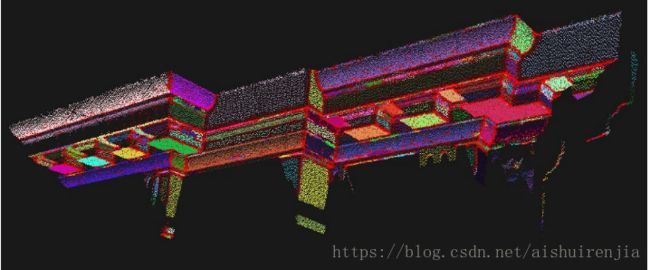PCL中的区域生长分割(region growing segmentation)
在本博文中,我主要介绍如何在pcl::RegionGrowing类中调用区域增长算法。首先注意一点,这里是region growing segmentation,不是color-based region growing segmentation.
算法核心:该算法是基于点法线之间角度的比较,企图将满足平滑约束的相邻点合并在一起,以一簇点集的形式输出。每簇点集被认为是属于相同平面。
工作原理:首先需要明白,区域增长是从有最小曲率值(curvature value)的点开始的。因此,我们必须计算出所有曲率值,并对它们进行排序。这是因为曲率最小的点位于平坦区域,而从最平坦的区域增长可以减少区域的总数。现在我们来具体描述这个过程:
1.点云中有未标记点,按照点的曲率值对点进行排序,找到最小曲率值点,并把它添加到种子点集;
2.对于每个种子点,算法都会发现周边的所有近邻点。1)计算每个近邻点与当前种子点的法线角度差(reg.setSmoothnessThreshold),如果差值小于设置的阈值,则该近邻点被重点考虑,进行第二步测试;2)该近邻点通过了法线角度差检验,如果它的曲率小于我们设定的阈值(reg.setCurvatureThreshold),这个点就被添加到种子点集,即属于当前平面。
3.通过两次检验的点,被从原始点云去除。
4.设置最小点簇的点数min(reg.setMinClusterSize),最大点簇为max(reg.setMaxClusterSize)。
4.重复1-3步,算法会生成点数在min和max的所有平面,并对不同平面标记不同颜色加以区分。
5.直到算法在剩余点中生成的点簇不能满足min,算法停止工作。
算法具体的伪码表示:http://pointclouds.org/documentation/tutorials/region_growing_segmentation.php#region-growing-segmentation
实现算法的工程文件中的代码,.cpp:
#include#include #include #include #include #include #include #include #include #include int main (int argc, char** argv) { pcl::PointCloud<pcl::PointXYZ>::Ptr cloud (new pcl::PointCloud<pcl::PointXYZ>); if ( pcl::io::loadPCDFile <pcl::PointXYZ> ("region_growing_tutorial.pcd", *cloud) == -1) { std::cout << "Cloud reading failed." << std::endl; return (-1); } pcl::search::Search<pcl::PointXYZ>::Ptr tree = boost::shared_ptr<pcl::search::Search<pcl::PointXYZ> > (new pcl::search::KdTree<pcl::PointXYZ>); pcl::PointCloud <pcl::Normal>::Ptr normals (new pcl::PointCloud <pcl::Normal>); pcl::NormalEstimation<pcl::PointXYZ, pcl::Normal> normal_estimator; normal_estimator.setSearchMethod (tree); normal_estimator.setInputCloud (cloud); normal_estimator.setKSearch (50); normal_estimator.compute (*normals); pcl::IndicesPtr indices (new std::vector <int>); pcl::PassThrough<pcl::PointXYZ> pass; pass.setInputCloud (cloud); pass.setFilterFieldName ("z"); pass.setFilterLimits (0.0, 1.0); pass.filter (*indices); pcl::RegionGrowing<pcl::PointXYZ, pcl::Normal> reg; reg.setMinClusterSize (50); reg.setMaxClusterSize (1000000); reg.setSearchMethod (tree); reg.setNumberOfNeighbours (30); reg.setInputCloud (cloud); //reg.setIndices (indices); reg.setInputNormals (normals); reg.setSmoothnessThreshold (3.0 / 180.0 * M_PI); reg.setCurvatureThreshold (1.0); std::vector <pcl::PointIndices> clusters; reg.extract (clusters); std::cout << "Number of clusters is equal to " << clusters.size () << std::endl; std::cout << "First cluster has " << clusters[0].indices.size () << " points." << endl; std::cout << "These are the indices of the points of the initial" << std::endl << "cloud that belong to the first cluster:" << std::endl; int counter = 0; while (counter < clusters[0].indices.size ()) { std::cout << clusters[0].indices[counter] << ", "; counter++; if (counter % 10 == 0) std::cout << std::endl; } std::cout << std::endl; pcl::PointCloud <pcl::PointXYZRGB>::Ptr colored_cloud = reg.getColoredCloud (); pcl::visualization::CloudViewer viewer ("Cluster viewer"); viewer.showCloud(colored_cloud); while (!viewer.wasStopped ()) { } return (0); }
注释:
1.文件输入、输出最好使用绝对路径;
2.代码中涉及到的参数:
setKSearch(): 这是在计算点的法线时,设置邻域内需要多少点来模拟平面计算法线。法线计算:http://geometryhub.net/notes/pointcloudnormal
setMInClusterSize() setMaxClusterSize() 原理中已经提到
setNumberOfneighbours() 指的是区域增长时种子点附近纳入检验的点数
setSmoothnessThreshold() setCurvatureThreshold() 原理中已经提到。这两个阈值的设置尤其重要,它们是region growing segmentation的核心。
3.注意,输入点点类型为 pcl::PointCloud
4.cmake文件参照如下:
cmake_minimum_required(VERSION 2.8 FATAL_ERROR) project(region_growing_segmentation) find_package(PCL 1.5 REQUIRED) include_directories(${PCL_INCLUDE_DIRS}) link_directories(${PCL_LIBRARY_DIRS}) add_definitions(${PCL_DEFINITIONS}) add_executable (region_growing_segmentation region_growing_segmentation.cpp) target_link_libraries (region_growing_segmentation ${PCL_LIBRARIES})
最后,区域增长算法已经是比较老的平面分割算法。希望大家能提出更好的算法。
参考资料:http://pointclouds.org/documentation/tutorials/region_growing_segmentation.php#region-growing-segmentation
